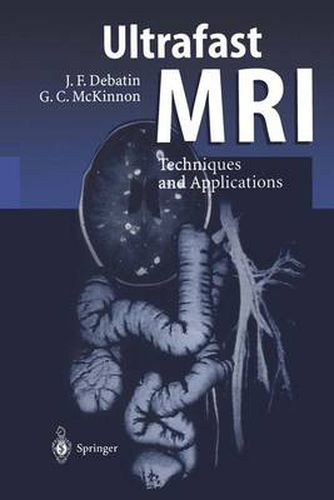Readings Newsletter
Become a Readings Member to make your shopping experience even easier.
Sign in or sign up for free!
You’re not far away from qualifying for FREE standard shipping within Australia
You’ve qualified for FREE standard shipping within Australia
The cart is loading…






This title is printed to order. This book may have been self-published. If so, we cannot guarantee the quality of the content. In the main most books will have gone through the editing process however some may not. We therefore suggest that you be aware of this before ordering this book. If in doubt check either the author or publisher’s details as we are unable to accept any returns unless they are faulty. Please contact us if you have any questions.
The imaging potential of the MR experiment continues to evolve. In recent years, an increasing number of fast and ultrafast imaging strategies has been described. In this evolu tion the definition of the terms fast and ultrafast has been blurred. Hence they are frequently used interchangeably. The evolution of these methods has been based on two related, yet separate developments: an increasingly thorough understand ing of the complexities inherent to pulse sequence design and the increasing availability of stronger and faster gradient sys tems. The combination of these two factors has laid the foun dation for vast reductions of MRI data acquisition times. Min utes have been replaced by seconds. Beyond shortening MR examination times and thereby increasing patient throughput, a most significant consequence has been the ability to acquire complex MR image sets within the time confines of a single breath-hold. The constraints placed by the presence of respi ratory motion have thus been effectively eliminated. Ultrafast breath-held data acquisition strategies already represent the backbone of many abdominal, thoracic and even pelvic imaging protocols. The enhanced image quality permits full exploitation of the unsurpassed soft tissue contrast inherent to the MR experiment. Beyond improving the quality of ex isting applications, the implementation of ultrafast imaging techniques has permitted the exploration of new imaging in dications, particularly in the area of perfusion and diffusion as well as ultrafast 3D imaging.
$9.00 standard shipping within Australia
FREE standard shipping within Australia for orders over $100.00
Express & International shipping calculated at checkout
This title is printed to order. This book may have been self-published. If so, we cannot guarantee the quality of the content. In the main most books will have gone through the editing process however some may not. We therefore suggest that you be aware of this before ordering this book. If in doubt check either the author or publisher’s details as we are unable to accept any returns unless they are faulty. Please contact us if you have any questions.
The imaging potential of the MR experiment continues to evolve. In recent years, an increasing number of fast and ultrafast imaging strategies has been described. In this evolu tion the definition of the terms fast and ultrafast has been blurred. Hence they are frequently used interchangeably. The evolution of these methods has been based on two related, yet separate developments: an increasingly thorough understand ing of the complexities inherent to pulse sequence design and the increasing availability of stronger and faster gradient sys tems. The combination of these two factors has laid the foun dation for vast reductions of MRI data acquisition times. Min utes have been replaced by seconds. Beyond shortening MR examination times and thereby increasing patient throughput, a most significant consequence has been the ability to acquire complex MR image sets within the time confines of a single breath-hold. The constraints placed by the presence of respi ratory motion have thus been effectively eliminated. Ultrafast breath-held data acquisition strategies already represent the backbone of many abdominal, thoracic and even pelvic imaging protocols. The enhanced image quality permits full exploitation of the unsurpassed soft tissue contrast inherent to the MR experiment. Beyond improving the quality of ex isting applications, the implementation of ultrafast imaging techniques has permitted the exploration of new imaging in dications, particularly in the area of perfusion and diffusion as well as ultrafast 3D imaging.